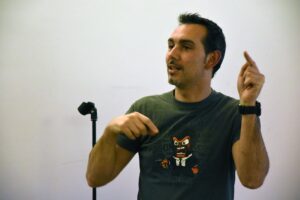
Ph.D in Condensed Matter Physics by the University of Oviedo ( Extraordinary Doctorate Award 2010) within the Prof. Alameda group under the supervision of Dra. M Vélez and Dr. J L Menendez. Since 2003 working on nanostructured magnetic systems, specially on magnetic configuration and domain walls (DW) dynamics in nanostructured thin films, studying how they modify their magnetization reversal processes.
I’ve been working on micro and nanostructured systems, from fabrication (e-beam and UV lithography, etching, growth…) to characterization (AFM, MFM, SEM, MOKE, magnetotransport measurements and micromagnetic simulations, studying the magnetic configuration and DW dynamics in thin film magnetic systems with non-magnetic inclusions in both, isolated and arranged in periodic arrays, contributing to the development of several models explaining the interaction between defects and the magnetic domains.
In the framework of the Nanopyme European project, at IMDEA nanoscience, I have designed and implemented a GPU-based supercomputing node for micromagnetic calculations of thin film, polycrystalline and powder-like magnetic systems. Thus, we have been able to simulate powder-like hybrid systems in a statistically significative simulation space.
In 2017 I founded Ciencia a la Carta, an association for scientific diffusion, nowadays with 40 scientific collaborators. Whithin this project, I lead and coordinate Cienciatres, a weekly space in SER Castilla-La Mancha.
Nowadays, I am associate professor in the Dept. of Applied Physics of the UCLM working with a low temperature (4K) MFM and SHPM (Scanning Hall Probe Microscopy) system and micromagnetic simulations, studying 0, 1 and 2 dimensional systems under external magnetic fields. My scientific work has been published in 23 scientific papers (19 JCR) and more than 60 congress communications.
I am specially interested in the study and development (design, computer simulation, fabrication and characterization) of micro and nanostructured hybrid systems aiming to obtain novel and simpler devices. In particular, I am interested in nanostructured systems (by 2D and 3D nanostructuration) capable not only of modifying their static magnetic behavior but being able to gain control on their dynamic response.